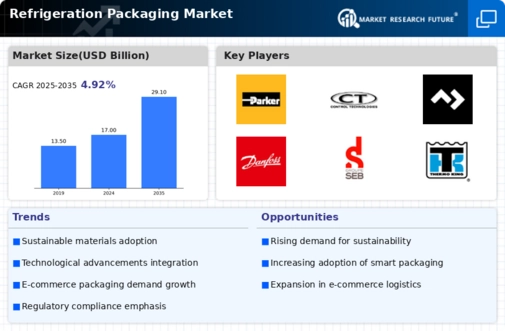Top Industry Leaders in the Refrigeration Packaging Market
 The refrigeration packaging market, a crucial cog in the global cold chain, is experiencing a period of dynamic growth and intense competition. driven by factors like rising demand for perishable goods, stricter food safety regulations, and advancements in sustainable packaging solutions. This dynamic landscape sees established giants like Sealed Air Corporation and International Paper Company jostling with innovative startups, all vying for a larger share of the icy pie.
The refrigeration packaging market, a crucial cog in the global cold chain, is experiencing a period of dynamic growth and intense competition. driven by factors like rising demand for perishable goods, stricter food safety regulations, and advancements in sustainable packaging solutions. This dynamic landscape sees established giants like Sealed Air Corporation and International Paper Company jostling with innovative startups, all vying for a larger share of the icy pie.
Strategies Adopted by Key Players:
-
Product Diversification: Offering a diverse range of packaging solutions for various temperature ranges, product types, and transportation needs caters to diverse customer requirements. Berry Plastics' extensive portfolio of insulated boxes and liners exemplifies this approach. -
Embracing Innovation: Investing in R&D fosters cutting-edge solutions. Mondi's development of self-cooling packaging with integrated phase-change materials and Sonoco Products Company's smart packaging with temperature sensors showcase this innovation focus. -
Strategic Partnerships and Acquisitions: Collaborations with material suppliers, technology providers, and logistics companies accelerate innovation and expand reach. WestRock Company's partnership with Apeel Sciences for plant-based edible coatings and Amcor Limited's acquisition of Bemis Company Inc. for its strong cold chain packaging portfolio illustrate this approach. -
Focus on Sustainability: Eco-friendly materials and production processes resonate with environmentally conscious consumers and businesses. Sealed Air Corporation's use of recycled paper pulp in packaging and Crown Holdings Incorporated's focus on compostable liners showcase this trend. -
Data-Driven Strategies: Leveraging data analytics to optimize cold chain logistics, track product movement, and predict spoilage risks enhance efficiency and reduce waste. Logisticon's cloud-based platform for cold chain management exemplifies this data-driven approach.
Factors Influencing Market Share:
-
Technological Advancements: Advancements in insulation materials, temperature monitoring technologies, and active packaging solutions create new market opportunities. Companies offering cutting-edge solutions gain an edge. -
Regulatory Landscape: Evolving regulations around food safety, traceability, and sustainability impact packaging materials and production processes. Adapting to these regulations swiftly is crucial for success. -
Cost-Effectiveness and Scalability: Striking a balance between affordability and high performance remains a primary concern. Companies employing lean manufacturing processes and leveraging economies of scale gain an advantage. -
Regional Growth and Demand: The rise of e-commerce and online grocery shopping in emerging markets like India and China drives demand for refrigerated packaging. Companies with strong regional presence and distribution networks gain an advantage. -
Customization and Niche Applications: Providing tailored solutions for specific product types and temperature requirements expands market reach. Sealed Air Corporation's focus on pharmaceutical cold chain packaging and Stora Enso's expertise in tamper-proof packaging for sensitive goods exemplify this trend.
Key Players:
Amcor Limited (Australia),
Ball Corporation (U.S.),
Bemis Company, Inc.(U.S.),
Crown Holdings Incorporated (U.S.).,
Graphic Packaging International, Inc.(U.S.),
International Paper Company (U.S.),
Pactiv LLC (U.S.),
Sealed Air Corporation (U.S.),
Sonoco Products Company (U.S.),
WestRock Company (U.S.).
Recent Developments:
-
August 2023: Sealed Air launches its "TempGuard IQ" real-time temperature monitoring system, offering enhanced visibility and control for perishable goods transportation. -
October 2023: Rockwel Automation expands its iTRAK cold chain monitoring system with new features for data analysis and reporting, aiding logistics optimization. -
December 2023: Dow Chemical Company unveils a new XPS insulation material with improved thermal performance and sustainability credentials, aiming to reduce energy consumption during transportation.

